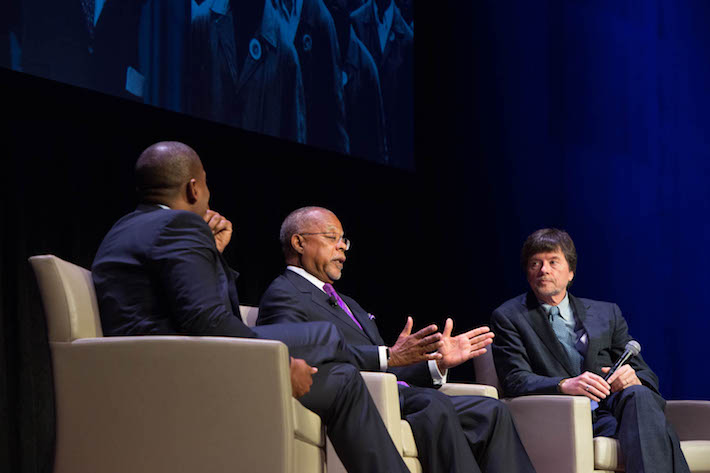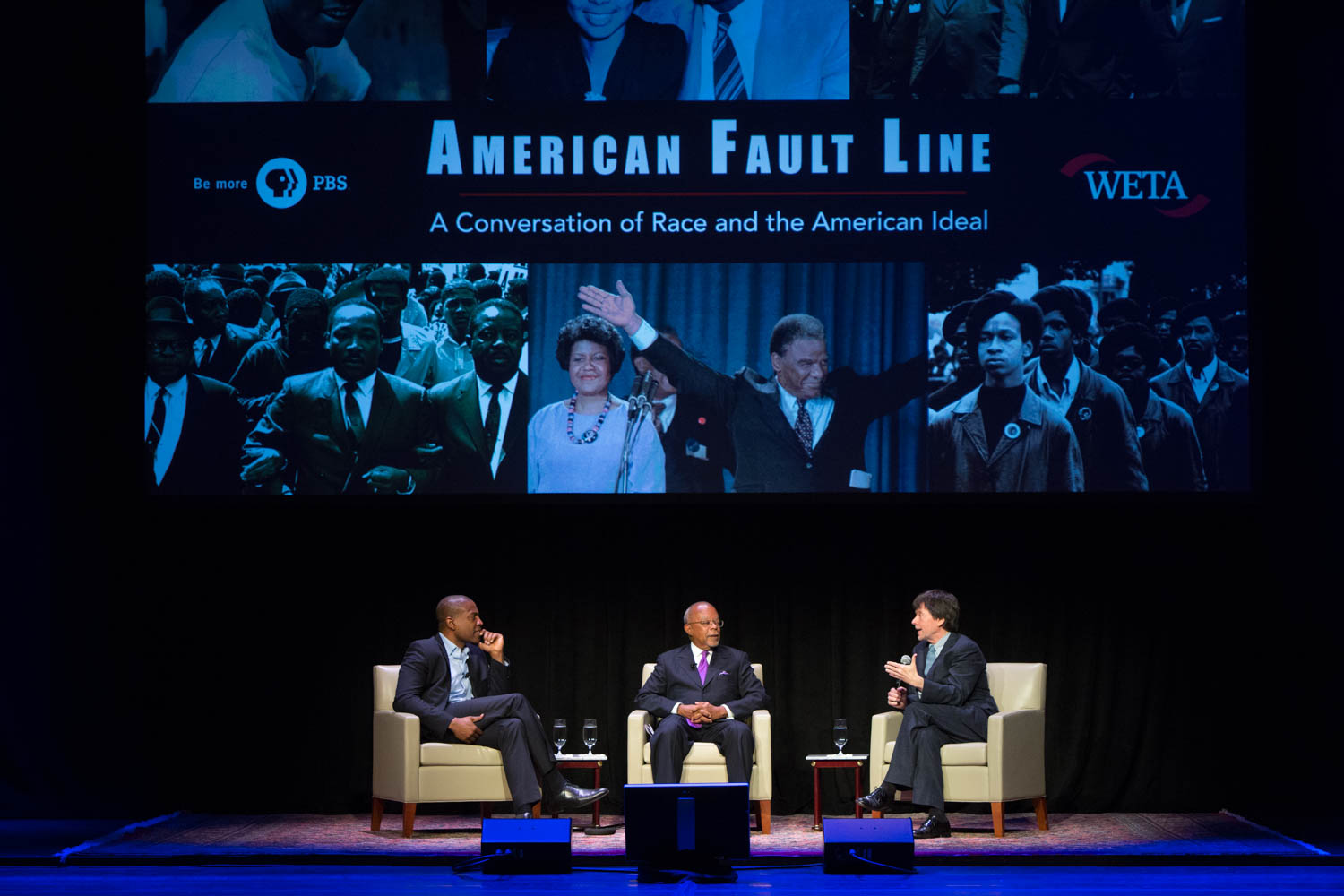By James Irwin
The two storytellers sat next to each other Monday night at the George Washington University and spent close to 90 minutes unraveling America’s thorniest topic: race.
“This is the center of American life, and it’s been there ever since Thomas Jefferson said all men are created equal but, oops, owned more than 100 human beings,” filmmaker Ken Burns said. “It set in motion an American narrative that is on the fault line of race.”
At an event presented by WETA and moderated by OZY co-founder Carlos Watson, Mr. Burns and Harvard University Professor Henry Louis Gates Jr. continued their multi-city speaking tour on race in America, a series they have hosted since the June 2015 shooting at Emanuel AME Church in Charleston, S.C.
Debunking mythology
Their upcoming documentary films—Mr. Burns’ “Jackie Robinson” and Dr. Gates’ “Black America Since MLK: And Still I Rise”—provide an opportunity to discuss race in America with historical perspective, Mr. Burns said.
He and Dr. Gates spent much of the night refuting simplified versions of that history.
“Oh, Martin Luther King came along, and we all sang ‘We Shall Overcome.’ But that’s not the way it was,” Dr. Gates said. “Martin Luther King was despised by some people.”
The truth, he said, is that there was turmoil—even within the African-American community—in the 1960s. Fierce arguments broke out during the time over whether to use nonviolent or violent action to promote the black cause.
“We disagreed about how to be black, we disagreed about what was efficacious in terms of making social change,” he said. “It’s very important for people to understand that.”
 The struggle and courage of everyday black Americans in 1960s resonated with Henry Louis Gates Jr., he said at Monday's event. (Logan Werlinger/GW Today)
The struggle and courage of everyday black Americans in 1960s resonated with Henry Louis Gates Jr., he said at Monday's event. (Logan Werlinger/GW Today)
The realities of Jim Crow
Mr. Burns uses Mr. Robinson—the man who broke baseball’s color barrier in 1947—to further quash misconceptions about a clean, flattened version of past events. Mr. Robinson, a four-sport star athlete at UCLA and an Army officer, was bombarded with racism in everyday life, even before he became a symbol of integration.
In a clip from the film featured Monday, Mr. Robinson’s widow, Rachel, recounts the couple’s 1946 trip to spring training—a multi-flight odyssey from California to Florida in which they were bumped from two planes in favor of white passengers and wound up taking a bus from Jacksonville to Daytona Beach.
Mr. Robinson’s mother, Mallie, anticipating a difficult trip, had given the couple a shoebox of fried chicken before they boarded the first flight.
“That’s what Mallie understood,” Mr. Burns said. “The older generation had an understanding of what it took to negotiate travel in the South.”
It was a time wrought with fear for African-Americans, he said.
“I think that we don’t fully appreciate what it was like to be African-American during that period—post-emancipation, pre-Civil Rights Act,” Mr. Burns said. “Just the act of having your kids walk home from school. They can be killed for play, for fun. That kind of fear hung over.”
Complex problems and solutions
These historical fractures and nuances are important for people to understand, Dr. Gates said. They can help assuage fears that contemporary race issues—which have spiked in recent years following the shooting deaths of Trayvon Martin, Tamir Rice and Michael Brown and the creation of Black Lives Matter—are too complex to tackle.
“Nobody has the solution to the problems of race, the problems of homophobia, the problems of anti-Semitism—there is no one solution to that,” he said. “The causes are complex, and how we combat them has to be equally complex.”
Mr. Robinson, Mr. Burns said, demonstrates an example of the complexity. He broke baseball’s color barrier before many landmark moments in the modern civil rights movement, including the integration of the military and Brown vs. Board of Education ruling by the Supreme Court.
That baseball was the mechanism meant something, he said.
“If you were a racist Dodgers fan, you had three choices,” Mr. Burns said. “You could stop rooting for the Dodgers, but Jackie’s arrival means the other teams are going to do it, too. You could change from baseball, but other sports are going to integrate. Or you could change.”
Contemporary challenges
Nearly 50 years after Dr. King’s death, race still remains a huge issue in America, Mr. Burns said. Even the election of Barack Obama—“an extraordinary thing,” he said—has triggered a regressive response.
Anecdotally, both Dr. Gates and Mr. Burns said they hear the “n-word” more often now than prior to President Obama’s election. There has been a destabilizing dynamic in electing an African-American, they said.
“A lot of Americans take the old guilts of slavery and permit them to metastasize into anger and resentment,” Mr. Burns said.
Dr. Gates put it more bluntly.
“It’s like a black man came to the White House and drove some people in America totally and completely out of their minds,” he said.
He believes that has at least partially fueled Donald Trump’s ascension to the top of the Republican presidential field. Mr. Trump, he said, is tapping into the fears of a significant segment of the American people.
“He seems to be making the contradictions in American society his meal ticket,” Dr. Gates said. “That’s demagoguery, and that’s dangerous, and when we see the violence at his rallies I’m afraid that’s going to spread.”
He advanced a rearguard approach to preventing that escalation.
“We don’t have enough honest conversations across the color line in this country where people can speak without fear—black or white,” he said.


